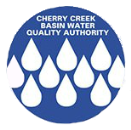2020 Annual Report on Activities
Cherry Creek Basin Water Quality Authority
Key Takeaways from Water Year 2020 (10/1/2019 – 9/30/2020)
It Takes Everyone
In 2020 CCBWQA, our Member Entities and Partners focused on meeting designated uses. In spite of the covid-19 pandemic, or perhaps partly because of it, Cherry Creek State Park was busy and Cherry Creek and Cherry Creek Reservoir provided space where people felt comfortable recreating and connecting.
While CCBWQA collaborates with its Member Entities and Partners, they demonstrate commitment to water quality through their own projects and policies. Water quality in the Cherry Creek Watershed continues to meet beneficial uses due to the efforts of many people and agencies.
Why Weather Matters
Monitoring data shows 2020 was drier than average. July and August were especially dry, with precipitation measuring 26% and 15% respectively based on the monthly averages of the same 12-year period. The dry year resulted in low inflow and lower than average storage.
The hot, dry, summer contributed to conditions that favored cyanobacteria growth, which led to harmful algal blooms. Cherry Creek Reservoir experienced harmful algae blooms that required closures of the swim beaches in July and early August. Fortunately, the Reservoir’s destratification system operated throughout the summer and the blooms could have been worse without the additional mixing provided.
thumb_down Chlorophyll a concentrations in the Reservoir exceeded the growing season standard, with a mean concentration of 28.4 ug/L compared with a standard of 18 ug/L.
thumb_up The Reservoir met the aquatic life standards for temperature, dissolved oxygen, and pH in WY 2020.
Point Sources
Wastewater
Wastewater Effluent in the Cherry Creek Basin has less phosphorus than background sources. As a percentage of overall flows, WWTF discharge made-up a larger percentage than in other years (due to low precipitation) and as indicated by lower than normal Phosphorus loading into Cherry Creek Reservoir.
Rueter-Hess Reservoir Resegmentation
Assigned its own segment within the Cherry Creek watershed, COSPCH07, CCBWQA is working with Parker Water and Sanitation District and other Member Entities with storage rights within Rueter-Hess Reservoir to ensure its operations as a water supply reservoir and that these operations do not negatively impact water quality in Cherry Creek and the Cherry Creek Reservoir.
Regulated Stormwater
MS4 permits for the Cherry Creek Basin require permittees to implement water quality control measures and the work done by CCBWQA’s Members with MS4 permits contribute to maintaining water quality in the Cherry Creek.
Non-Point Sources
Pollution Abatement Project Planning
Mile High Flood District is updating their Master Drainage Plan for Cherry Creek and CCBWQA is a partner in this update. While the current MDP, 2004, didn’t include active water quality features, MHFD has included water quality features in projects done in the Cherry Creek Basin for several years.
CCBWQA is actively researching sub-basins (11 previously unplanned Cherry Creek Tributary watersheds within Arapahoe County) as long-term data suggests effective PRF, Control Measure, BMP requirements differ because of specific sub-basin characteristics.
Riparian Areas and Wetlands
Riparian areas in the urbanized areas of Cherry Creek’s mainstem and some of its tributaries have improved over the past several years, the result of collaborative efforts by CCBWQA, CCBWQA’s Member Entities, Mile High Flood District, and others.
